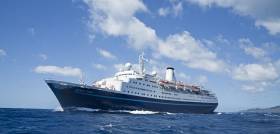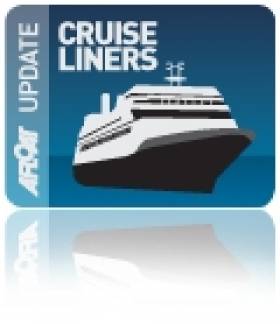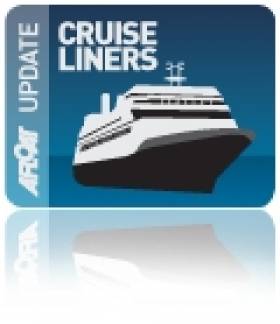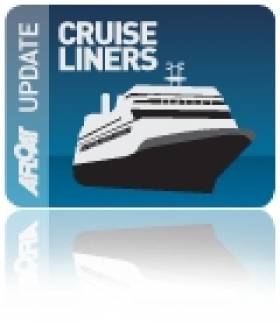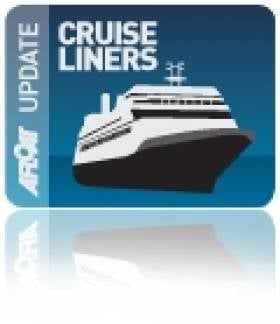Displaying items by tag: CMV
First of Two Festive Cruises Underway from UK to Irish Ports
#CruiseLiners - Classic cruiseship Marco Polo arrived to the Irish capital today as part of a Dublin Festive Mini-Cruise which includes an overnight call, writes Jehan Ashmore.
Cruise & Maritime Voyages (CMV) are the only operators serving Irish ports with this first of two separate festive themed cruises providing sightseeing and gift shopping opportunities. On completion of this three-night cruise which is to return to Avonmouth, (Port of Bristol) on Wednesday, passengers are to disembark in the port on the Severn Estuary.
Marco Polo dating to 1965, with capacity for 800 passengers which is small by today's standards, however given its classic former Soviet era liner heritage, this partially lends to an intimate atmosphere on board, noting interior lounge areas. In addition, there's plenty of open deck space featuring the classic horseshoe shaped aft decks and notably those forward, affording convenient views when visiting destinations, albeit given this time of the year, it would be the more hardy type to venture outside!
Also this Wednesday, another round of cruise-goers for the second cruise, marketed as the Festive Ireland Party Cruise commences with an afternoon departure. This cruise, again of three-night duration is to call to Cork (Cobh) Harbour on Thursday, where likewise of the Dublin cruise, an overnight will be spent on this occasion in the scenic Munster harbour town.
By overnighting in Cobh, this will enable those to also take in the tourist attractions of Cork City, given Marco Polo does not depart until Friday afternoon. An overnight passage follows across the Celtic Sea with a scheduled arrival back once more in Avonmouth, with an arrival on Saturday at around dawn.
Afloat's Visit On Board CMV's Magellan: 'Home-Porting' Again from Irish Ports in 2018
#VisitOnboard - Afloat took the opportunity to visit on board Cruise & Maritime Voyages (CMV) Magellan during a recent call to Dublin Port, writes Jehan Ashmore.
Upon embarking the gangway it was pleasing to see crew members giving a fresh coat of paint on the bow to the customary white hull that the majority of cruiseships have.
The call by Magellan to the capital was part of an 8-night packed-out 'Rock the Boat' private based charter cruise of the 1,250 passenger capacity ship. The cruiseship which only two years ago underwent a major refurbishment to meet the levels of CMV's 3 star service.
This season was the first for the UK operator's to offer 'home-porting' cruises out of Dublin, from where Irish passengers took direct non-fly cruises which by the way are also adults-only. In fact of the 9 cruises operated, almost all the Dublin departing holiday cruises were sold-out.
Following the success of this home-porting season out of Dublin, CMV are to repeat in 2018 but with increased cruises and adding another Irish departure port out of Cobh.
In total Magellan has 11 cruises on offer in 2018 and available through CMV's Irish agent JMG Cruise.com There will be 7 cruises operating from Dublin and 4 cruises departing Cobh.
In terms of accommodation there are 756 cabins (456 Ocean View / 270 inner) where the average size of Ocean View cabins are 13 sqm and for Inner are 12 sqm. At the higher end there are 14 Ocean View Suites, they average at 27sqm and come with balconies located on the Navigator Deck.
Among the cruises out of Dublin will be the season's opening Iceland & Northern Isles cruise (12 nights) departing in early July, a Spain, Portugal & Gibraltar cruise (12 nights) in the following month of July. A more leisurely Baltic Cities & St. Petersburg (17 nights) takes place in early September.
As for Magellan's Cobh cruises this will begin with a Meditterranean Odyssey (15 nights) in September and followed by a Canary Islands & Madeira cruise also of the same duration but taking place in October. During that month a further two cruises take in European cities and as far as the Northern Lights.
The mid-sized cruise ship has 9 passengers decks served by a UK and international crew in addition to on board entertainers taking centre-stage of the ships two-deck high 'Magellan Show Lounge'. This is the most impressive space given the two-deck high facility along with windows stepped down either side towards the stage, a design feature of this Danish built ship.
On board the overall impression of interiors were tasteful, airy and so easy on the eye. No doubt the ambiance was toned down to reflect her European market compared to starting a career in the US, where the ship's audience was targeting a younger profile with brash deco and bling.
Among the amenities firstly beginning with the dining options are the Kensington Restuarant & Waldorf, the latter restaurant has two-sittings in addition there's the choice of the Raffles Bistro.
As for some of the shipboard services, there's the relaxing ambience of the Hampton's Lounge Bar, the stylish gift shop -duty free, a hair & beauty salon, fitness centre, spa and 3 Jacuzzis, 2 swimming pools (outside) though not heated.
So what about evening entertainment, there's the Captain's Night Club, a Casino and the aforementioned Magellan Show Louge offering a wide range of entertainment.
With all these facilites and entertainment, should you wonder as to the dress code? On formal nights (there is one in general each week) leaving the rest to informal and casual nights.
Home-Porting of CMV's Magellan in Dublin This Season to be Repeated in 2018 with New Cobh Departures
#DirectCruises - Home-porting of Cruise & Maritime Voyages current flagship Magellan directly from Dublin Port this season are to be repeated in 2018 with new Cobh departures added, writes Jehan Ashmore.
Magellan is CMV's adult-only friendly flagship that is to offer the Irish market with five 'No Fly' home-porting cruises this season based out of Dublin.
As previously reported these first direct CMV cruises from the capital, will begin with a 9 night Fjordland Splendour cruise on 5 June. This cruise will incorporate those already embarked having taken a 2-night Dublin Mini-Cruise from Newport, Wales that ends in Liverpool.
Among the Irish based cruises sold through JMG Travel, begins in Dublin on 7 June a ‘Summertime Gardens & River Seine Experience’ cruise. Twin Ocean View Cabins are currently available from €1349pp.
As part of this 7-night cruise Magellan is to navigate inland along the beautiful River Seine for an overnight stay in the gothic cathedral city of Rouen. The French city that was the historic capital of Normandy is where you can follow in the footsteps of Joan of Arc and Richard the Lion heart. Further upriver is the village of Giverny and the home and gardens of Claude Monet, who captured the beauty of Rouen in many of his paintings.
Season 2018 includes Cobh
For next year the 2018 season will see CMV repeat the 'No Fly' cruises based out of Irish ports but increased to total 11 cruises. Of these cruises, seven are from Dublin while the remaining four are in Cobh. Among the destinations (subject to departure port) are Icelandic and Norwegian fjords, the Iberian Peninsula including Gibraltar, Canary Islands & Madeira, a Mediterranean Odyssey and a Baltic Cities cruise featuring St. Petersburg.
The 46,052 gross tonnage Magellan christened by Gloria Hunniford became CMV’s flagship in 2015. There are plenty of observation lounges and wide timber decks to take in the sights. Accommodation for around 1,250 passengers are provided in 726 Cabins that include 14 Balcony Suites. The 221m flagship is fully stabilised and air conditioned throughout nine passenger decks.
As also previously reported Magellan as current flagship is to be succeeded soon by a replacement, Pacific Pearl acquired from P&O Australia. The new 63,786 gross tonnage /1,400 passenger flagship is to be christened Columbus on this date in June at a ceremony held in London Cruise Terminal, Tilbury.
The new flagship having taken on the role is to make an Irish debut to Dublin also next month.
CMV’s Classic Ocean Going Lady Calls to the Capital
#ClassicCaller – Cruise & Maritime Voyages Marco Polo, a classic cruiseship that became the first ship to establish the UK operator almost a decade ago, made a call to Dublin Port today, writes Jehan Ashmore.
The call of the 820-passenger Marco Polo now in its 52 year is in complete contrast to the 2004 built giant Caribbean Princess which called to the capital at the weekend. The 112,894 gross tonnage ship however was in the media spotlight last year (see report) in regards to a 'magic pipe'.
As for Marco Polo the ship departed last week from Avonmouth near Bristol. The seven-nights Scottish Highlights & Emerald Isle cruise last port of call was Tobermory on the Isle of Mull.
Marco Polo became CMV’s first ship in 2009 and using embarkation ports in the UK among them Tilbury, London Cruise Terminal. This season she is mainly based out of Avonmouth, Bristol and Hull. Afloat has identified among its cruises is a one-night taster in September. This is to be from Belfast to Liverpool.
The career of this classic former Soviet era liner dating to 1965 was incorrectly reported by Ships Monthly to be up for sale and be withdrawn in 2018. The publication added that Marco Polo is to remain in service at least to the end of next year as according to the operator’s advertised cruise roster.
Afloat has also examined Marco Polo’s season next year. Among the season is a five night Emerald Isle & Isles of Scilly. This cruise based out of Cardiff is to include calls to Dublin, Cobh and Glengariff, Bantry Bay from where the lady of the sea was observed from the shoreline almost a decade ago. This saw tenders kept busy bringing cruise-goers ashore from the anchored ship.
Asides her rare longetivity, Marco Polo is notably the sole survivor of five sisters built of the so called ‘Authors’ class, having been built in Wismar, East Germany. Launched as Alexandr Pushkin, the liner operated Baltic Shipping Company’s Leningrad—Helsinki—Copenhagen—London (Tilbury)—Quebec City—Montreal, Canada service.
This liner trade however ceased within a decade. The ship was sold but began a new career cruising that included operating in the Far East and Australia.
Dublin Port 2013 Cruise Season to Start with a New Discovery
#CRUISE LINERS – In 2013 Cruise & Maritime Voyages are to charter Discovery (1971/20,216grt) for the UK cruising season to directly replace Ocean Countess, writes Jehan Ashmore.
The charter of the 700 passenger Discovery from Voyages of Discovery will see her operate cruises from Bristol Avonmouth, Liverpool, Hull and Harwich. As part of the charter arrangement her owners will also market the vessel during the season as Discovery Sailaway.
Discovery will undergo an extensive winter dry-docking and refurbishment programme prior to joining the CMV fleet in February 2013.
Her inaugural 'Irish' call will also mark the first cruise caller next year to Dublin Port scheduled on 8 April during a 5-night Springtime Gardens and Charms Cruise. Sharing the season will be CMV's slightly larger 800 passenger Marco Polo (1965/22,080grt).
Autumn Cruise Heads for Sunnier Climes
#CRUISELINERS- Cruise & Maritime Voyages (CMV) Ocean Countess (1976/16,795grt) is scheduled to depart Dublin Port this evening, writes Jehan Ashmore.
The Portuguese flagged vessel is to start on a 14-nights "Canaries & Madeira" cruise, with Irish passengers having the opportunity to embark directly in the capital.
She is to sail overnight to Liverpool, however her first Iberian port of call to Lisbon, is not until this Friday. Fares for the fortnight cost from £1,207 sterling and the cruise was organised through John Galligan Travel.
CMV also operates another veteran with the slightly older Marco Polo (1973/19,860grt) which too is a regular visitor to the port.
Cruise Caller Line-Up for Galway Harbour
#CRUISE LINERS- Galway Harbour can look forward to welcoming nine cruise calls to the mid-west port this year, with the first visitor being Arion which is scheduled to arrive in Galway Bay during late May, writes Jehan Ashmore.
Arion harks back to an era of the more classically designed ships with graceful sweeping lines. The 5,888 tonnes veteran vessel was launched in 1965 at Pula, in Croatia, as Istra and later in her career she underwent a major reconstruction in a Lisbon shipyard during 2000.
Cruise & Maritime Voyages (CMV) will be sending their Marco Polo, another classic veteran, in July as part of a 12 night 'Emerald Isle' discovery cruise departing Tilbury, with en-route calls to Cobh and Glengariff the previous day.
For a full listing of the cruise-calls schedule click HERE.
Dublin Port Turn-Around Offers Direct Cruises to the Sun
With a short-turn around in port, more cruise-goers will be boarding for a mid-afternoon departure, marking the start of a 13-night Canary Islands & Madeira cruise. When she heads out of the port, the first port of call is Falmouth then it's off to Leixoes (Portugal), Agadir (Morocco), Arrecife (Lanzarote), Las Palmas (Gran Canaria), Funchal (Madeira), Lisbon (Portugal) and Vigo (Spain) before returning to Dublin.
The vessels final end-of season cruise from Dublin is on 25 October, with a 10-night cruise to Nice (returning by air). The interim ports of call are to Falmouth, Leixoes, Lisbon, Cartagena (Spain) Palma and Mahon (Menorca). To read more about this cruise click HERE.
In addition to Dublin calls the former Cunard Countess, also called this season to Cork Harbour. It was during a call last month to Ringaskiddy that another 'Cunarder' the flagship, Queen Mary 2 was also in port on a call to Cobh. To read more of that visit click HERE.
Former Soviet-Bloc Liner Continues Cruising
Cruising off the east coast of Leinster this evening is the veteran cruiseship Marco Polo which is bound for the Scilly Isles off Land's End, writes Jehan Ashmore.
For those with an appreciation for the more traditional tiered deck profile compared to the bulky new giant cruiseships, the 22,080 tonnes vessel built as the Aleksandr Puskin at the Mathias-Thesen-Werft, East Germany, certainly represents a different era.
The liner entered service in 1966 with the Baltic Shipping Company on their regular trans-Atlantic Montreal-Leningrad service. In 1975 she was converted for her new role as a full-time cruiseship. For a cut-away deck profile and description of facilities click here.
She can take 850 passengers accommodated in 450 cabins. Her main dimensions reflect her ocean-going design noting her draft is 8.2m (26.9ft) with a length of 176.3m (578.4ft) and a beam of 23.6m (77.4ft). Crewing is divided between senior officers (international) and cruise staff and entertainers are both British and comprising of other nationalities.
In recent years Marco Polo served the German market but she now is run by Cruise & Maritime Voyages (CMV) on cruises from the UK. The company also operate the Ocean Countess which first started out her days as Cunard Countess.



























